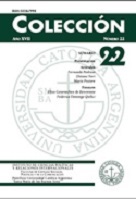Please use this identifier to cite or link to this item:
https://repositorio.uca.edu.ar/handle/123456789/6992| Título: | Hannah Arendt y Walter Benjamin : masa, multitud, populacho | Autor: | Goyenechea, Elisa | Palabras clave: | Arendt, Hannah, 1906-1975; Benjamin, Walter, 1892-1940; IMPERIALISMO; TOTALITARISMO; MASA | Fecha de publicación: | 2012 | Editorial: | Pontificia Universidad Católica Argentina. Facultad de Ciencias Sociales, Políticas y de la Comunicación. Instituto de Ciencias Políticas y Relaciones Internacionales | Cita: | Goyenechea de Benvenuto, E. Hannah Arendt y Walter Benjamin : masa, multitud, populacho [en línea], Colección. 2012, 22. Disponible en: https://repositorio.uca.edu.ar/handle/123456789/6992 | Resumen: | Resumen: Hannah Arendt y Walter Benjamin examinan los fenómenos asociativos de masa, multitud y populacho. Ambos sustraen tales grupos del ámbito político y los sitúan en el ámbito social. En Los orígenes del totalitarismo, Arendt indaga la noción de populacho o mob en el contexto del fenómeno imperialista. Asocia el carácter del populacho con el de la clase burguesa y posiciona ambos grupos en la emergencia de los nacionalismos tribales, ambos antecesores del totalitarismo. La masa es consustancial con los regímenes totalitarios. La apatía cívica, el cinismo y el derrumbe de las costumbres burguesas no alcanzan para explicar el fenómeno totalitario. El hombre masa ha perdido incluso el interés por sí mismo y el gusto por las asociaciones no partidarias. Walter Benjamin reflexiona literariamente los fenómenos de la bohème y de la multitud (crowd), a través de la poesía de Baudelaire y los relatos de Poe. El primer grupo incluye los conspiradores profesionales, cuyo aislamiento y resentimiento los emparenta con los miembros del mob. La falta de pertenencia y la ausencia de vínculos los conduce al activismo, sin un programa de acción. En el contexto de su reflexión sobre el fenómeno de la multitud, Benjamin indaga el impacto de las condiciones de vida moderna en las conductas automatizadas de los individuos. Los comportamientos reflejos, las respuestas automatizadas y los clichés, son las notas que también Arendt encuentra en el hombre “normal” y diluido en la masa, como lo evidenció la conducta de Eichmann durante el proceso en Jerusalén Abstract: Hannah Arendt and Walter Benjamin review the associative phenomena of mass, crowd and mob. Both subtract those groups from the political sphere and place them in the social field. In The origins of Totalitarianism, Arendt explores the notion of mob in the context of the imperialist phenomenon. She associates mob character with the character of the bourgeois class and positions both groups in the emergence of tribal nationalism, both precedents of totalitarianism. Civic apathy, cynicism and the collapse of bourgeois manners are insufficient to explain the phenomenon of totalitarianism. The mass man has even lost self-interest and a taste for non-political associations. Walter Benjamin ponders the phenomena of literary and bohemian crowd through the poetry of Baudelaire and the stories of E. A. Poe. The first group includes professional conspirators, whose isolation and resentment, ties these to the members of the mob. The lack of ownership and the absence of links lead to activism, not an action plan. In the context of its reflection on the phenomenon of the crowd, Benjamin explores the impact of modern living conditions in the automated behavior of individuals. The reflex behaviors, automated responses and the clichés are also Arendt notes in the “normal” man and diluted in the mass, as evidenced by the behavior of Eichmann in Jerusalem during the process |
URI: | https://repositorio.uca.edu.ar/handle/123456789/6992 | ISSN: | 0328-7998 | Disciplina: | CIENCIA POLITICA | Derechos: | Acceso Abierto | Fuente: | Colección, nº 22, 2012 |
| Appears in Collections: | COL - 2012 Año XVII nro. 22 |
Files in This Item:
| File | Description | Size | Format | |
|---|---|---|---|---|
| arendt-benjamin-masa.pdf | 302,71 kB | Adobe PDF |  View/Open |
Page view(s)
1,055
checked on Apr 27, 2024
Download(s)
746
checked on Apr 27, 2024
Google ScholarTM
Check
This item is licensed under a Creative Commons License

